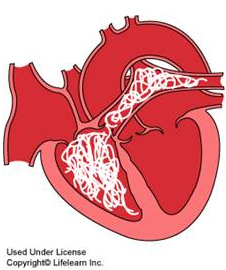
Heartworms kill a great number of dogs. They are spread from animal to animal by mosquitoes and live in the heart and pulmonary arteries of infected animals. The disease can lead to heart failure, as well as damage to other organs. In fact, the American Heartworm Society reports that more than one million dogs currently have heartworm disease. They also report that heartworm is a serious canine and feline health concern that threatens animals in all 48 contiguous states and Hawaii, as well as throughout the temperate regions of the world including some areas of Canada.
If you are planning on travelling to a Heartworm endemic area please see us first for preventative medications.
Heartworm disease is a serious and potentially fatal condition caused by parasitic worms living in the arteries of the lungs and occasionally in the right side of the heart of dogs, cats and other species of mammals, including wolves, foxes, ferrets, sea lions and (in rare instances) humans. Heartworms are classified as roundworms and are filarids, one of many species of roundworms. Dogs and cats of any age or breed are susceptible to infection.
Filarids rely on different insect species to be transported from animal to animal. The specific filarid causing heartworm in dogs and cats is known as Dirofilaria immitis.
Dogs or other animals harboring adult worms are the recognized reservoir of heartworm infection. The disease is spread by mosquitoes that become infected with microfilariae while taking a blood meal from an infected dog. Within the mosquito, the microfilariae mature into the infective larval stage. When the mosquito then bites another dog, cat, or susceptible animal, the larvae are deposited on the skin and actively migrate into the new host. For about 2 months the larvae migrate through the connective tissue, under the skin, then pass into the animal’s venous blood stream and are quickly transported to the arteries of the lung. It takes a total of approximately six months for the infective larvae to mature into adult worms that begin producing offspring, microfilariae. Adult heartworms can live for five to seven years in the dog.
In the dog, the larvae progress in their development to an adult form of the worm, and live in the pulmonary vessels, where they continue the life cycle and cause extensive injury. The period of time when heartworms are reproductively capable is referred to as patency. In cats, it takes seven to eight months before adult worms potentially reach patency in the pulmonary vessels, and this is referred to as transient patency, as reproductive capability in the cat is usually very short (months) compared to that of dogs (years). In most cases the cat is not an effective reservoir host, since microfilaria are produced in less than 20% of the cats.
In the cat, the larvae molt as well, but fewer worms survive to adulthood. While dogs may suffer from severe heart and lung damage from heartworm infection, cats typically exhibit minimal changes in the heart. The cat’s primary response to the presence of heartworms occurs in the lungs.
from American Heartworm Society
 When they bite, mosquitoes can transmit heartworm infection. And those heartworms can wreak havoc on your dog or cat. These parasites can severely and sometimes fatally damage the heart, lungs, and blood vessels. Some pets may not show any signs of infection; in those that do, symptoms can vary widely.
When they bite, mosquitoes can transmit heartworm infection. And those heartworms can wreak havoc on your dog or cat. These parasites can severely and sometimes fatally damage the heart, lungs, and blood vessels. Some pets may not show any signs of infection; in those that do, symptoms can vary widely.
In dogs, signs of heartworm disease can range from coughing, fatigue, and weight loss to difficulty breathing and a swollen abdomen (caused by fluid accumulation from heart failure). Canine heartworm infection can also lead to a life-threatening complication called “caval syndrome” (a form of liver failure); without prompt surgical intervention, this condition usually causes death.
Although often thought to not be susceptible to heartworm infection, cats can indeed get heartworms. Cats can suffer from a syndrome referred to as heartworm-associated respiratory disease (HARD); the symptoms can be subtle and may mimic those of asthma or allergic bronchitis. Signs of respiratory distress, such as rapid or difficult breathing, wheezing, and panting, are common. Other symptoms include coughing, vomiting (typically unrelated to eating), and loss of appetite or weight. Heartworm infection is more difficult to diagnose in cats than it is in dogs.
Treatment for heartworm infection is far more expensive than prevention—and it can actually kill your dog. There is no approved treatment for cats. Some cats spontaneously rid themselves of the infection; others might not survive it. And even one or two adult heartworms in a cat can cause serious problems.
Fortunately, there’s an easy way to keep your dog or cat safe: by administering monthly heartworm preventives. Most heartworm medications also protect your pet against other parasites, such as roundworms, hookworms, whipworms, ear mites, fleas, and ticks. We can recommend the best regimen of prevention for your pet.

